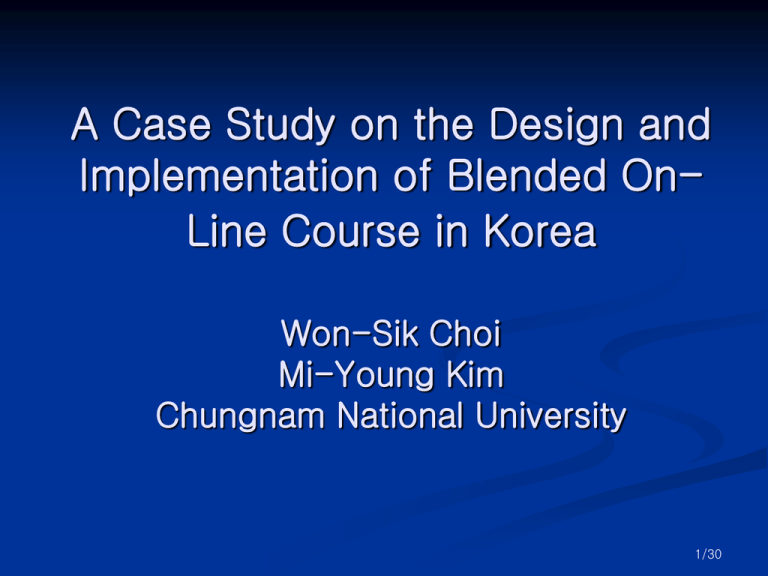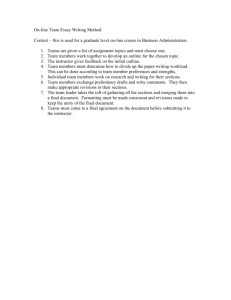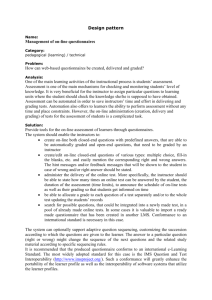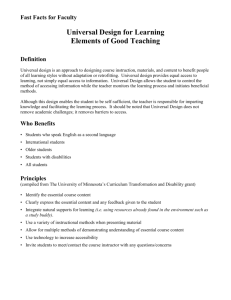Large Scale Blended e-Learning case in CNU
advertisement

A Case Study on the Design and Implementation of Blended OnLine Course in Korea Won-Sik Choi Mi-Young Kim Chungnam National University 1/30 General Class situations in Korean Universities Today’s college school educational environment in Korea is generally focused on homework and other activities which need more than off-line classes. But in reality, it is also impossible to conduct teaching and learning only by on-line classes. 2/30 General Class situations in Korean Universities Many classes in universities cannot use various, high-quality materials in the classroom, so we are forced to depend on a closed curriculum with a textbook that focuses on a limited amount of knowledge. This causes a big problem especially when the students/instructor ratio is very high. 3/30 Solving the Problem One of the methods which can solve the problem associated with big-size classes that universities face is to use on-line classes (Bourne et al., 1997; Choi, AECT 2005). This approach itself, however, cannot be a big help when considering the quality of education, and it can often cause a result which is far less than that of traditional face-to-face education. 4/30 Solving the Problem Face-to-face interactions permit an instructor to rapidly change the direction of the discussion and to directly satisfy the needs of the learners. The group can also rapidly interact and come to agreement. Therefore, we need to use on-line classes for big-size classes as a form of on-line and off-line blended learning. 5/30 A Reason to Use Blended Learning Modality To help people learn, we use the best means for a particular subject. We usually don’t learn to drive from a book, and we don’t learn mathematical theorem by trial-and-error. A blending of means always works better than just one. 6/30 The Purpose of this Study The educational purpose of this study is to suggest the adaptability of blended learning to the university classes by using the students’ responses after the designing and conducting an actual example of blended learning for a course in a Korean university. 7/30 Methodology The subjects were 165 students who signed up for a Computer Technology class which was opened in the department of Technology Education at CNU during the spring semester of 2005. Computer Technology is a required 3 credit hour course for those who want to receive a secondary school “Technology” teacher certificate. 8/30 Methodology The learning contents during the 13 weeks except for the mid-term and final exam days were selected. Web page contents were developed using HTML, Flash, and Photoshop. The overall system was constructed by using a LMS. It was made so as to have a instructor’s mode and a learner’s mode, and each had different functions and interfaces. 9/30 Screen for instructor’s mode 10/30 Screen for a student’s mode 11/30 LMS Site Scheme Log-in Home Learning Menu Learning Support Menu Question to sysop Web-mail (in & out box) survey Question to instructor Resource Site Assignment submission Project team activities Learning Resources - Lecture contents Public Conference - Syllabus - Evaluation Public Announcement Help desk Site-map Home Chatting-room Lecture room Private team home site • Check 조별메인화면 in 조별메인화면 • Announcement • 가입하기 •plan 가입하기 • Activity • 조별공지사항 •activities 조별공지사항 • Project • 조별활동계획 • 조별활동계획 • 조별활동내용 • Q&A to •instructor 조별활동내용 • Q&A to instructor • Q&A to instructor 12/30 Methodology The students were required to write down the definition of the terminology listed at the end of each chapter and send it by email. When they had questions, they were encouraged to use the bulleting board, and for these questions, even students were allowed to answer them freely. It was announced that the grade would be given considering the numbers of student’s logs-ins and posts. 13/30 BBS for Questions and Answers 14/30 An Example of Course Content 15/30 Methodology One week before a new chapter began, the instructor had an orientation for the chapter through real-time chatting for an hour or a face-to-face class (the ratio of these two was 1:1). The instructor could identify whether the students had entered in the chatting rooms or not. Usually abut 90 to 140 students out of the 165 students had entered in the chatting room. 16/30 Chatting Room w/ List of Students 17/30 Methodology For the rate of off-line face-to-face participation including real time chatting, it is identified through the direct attendance, but for the rate of on-line participation, log information and the number of posts on a bulletin board provided by LMS were analyzed. 18/30 Log Information 19/30 Instructional Flow for a Chapter Chapter Instruction Begin Instructor Led Orientation (ILO) Using Chatting or Face-to-Face o o o Self-directed Instruction Sharing Resources Between Learners Cooperative Learning Between Learners Interchange with Subject Matter Experts Assignments Submission Question and Answer or ILO On-line/Off-line/Real-time Formative Evaluation o Start/Log-in On-line/Real-time On-line/ALN Off-line/Real-time On-line/ALN Off-line/Real-time On-line/ALN Next Chapter 20/30 Summary for the Roles of Instructor, Learner, and System manager Learner Learning schedule management Individual learning activities Learner's own group activities - Discussion, Assignment activities, and etc. Individual Information management Question & answer and discussion Sharing learning materials Instructor Instructor schedule management Evaluation management Learner's information management Examining and feedback on learner's learning activity Responding to a learner's question Making a survey on learner's opinion Writing official announcements BBS: Bulletin Board System Questioning to the instructor Web mail Chatting Room, and etc. System manager Learner's registration management System management Making orientation for learners Supporting interfaces 21/30 Results The GPA of the 165 participating students was 79.24(17.2 for SD). Even though there isn’t a significant difference BL and TL statistically, it suggests that this blended learning is educationally effective enough as a learning method, compared to the fact that the GPA is near 70(C) in a traditional class so far. 22/30 Results Each person submitted his/her assignments 9 times out of 10 on the average, and the number of diverse posts such as questions and answers for peers on the learning contents appeared in 389 cases, which means 4.18(389/165) cases a person were posted. 23/30 Results The average number of clicks on each post was 21(8169 clicks/389 posts) times, and the number of log-ins on each chapter appeared 4 times per a student on the average. 24/30 Results The results of the survey regarding the degree of learning satisfaction for the course showed that students do not feel burden as the class had an average score of fewer than 3.0 regarding negative questions, and a high degree of satisfaction for the class with the over 3.0 regarding positive questions. 25/30 Degree of Satisfaction Results I Questions Average(SD) At first, I was nervous about taking an on-line class, but I developed self-confidence as I participate in the class. 3.51(0.83) I think that an on-line class can complement insufficient parts of a classroom-oriented class. 3.39(0.99) The website was organized conveniently for users. 4.02(0.82) I think that the interaction between teacher and student was smooth in the cyber classroom. 3.21(0.88) I think that the interaction between teacher and student was helpful for learning in the cyber classroom. 3.60(0.74) 26/30 Degree of Satisfaction Results II Questions Average(SD) The interaction between teacher and student in the cyber classroom developed familiarity among each other. 3.83(0.94) This on-line class was positive since I could participate in the class regardless of time or place 4.17(0.88) It was useful to open information to the public and share it in the cyber classroom 3.64(0.82) The discussion with teacher/students in the cyber classroom was helpful for test preparation. 3.26(0.89) My participation in the cyber classroom discussions allowed me to broaden my analytical perspective. 3.19(0.87 ) 27/30 Degree of Satisfaction Results III Questions Average(SD) Whenever I post an article on the Internet, I felt uncomfortable since I am not familiar with sharing information with other people. 2.40(1.11) Once my article was posted on the web, I cared about the number of clicks on my article. 2.55(1.21) It was convenient to ask questions and check answers by using a bulletin board, regardless of time or place. 3.77(0.87) Overall, I am satisfied with this on-line class. 3.72(0.83) I feel like I learned a lot through this on-line class 3.36(0.99) 28/30 Conclusion The results were interpreted to suggest that introducing the blended learning method to the university class has positive aspect. Since this result was derived from a big-size 3 credit hour class with 165 students, the adapting the BL model to the any size class is possible and encouraging. 29/30 Thank You 30/30






